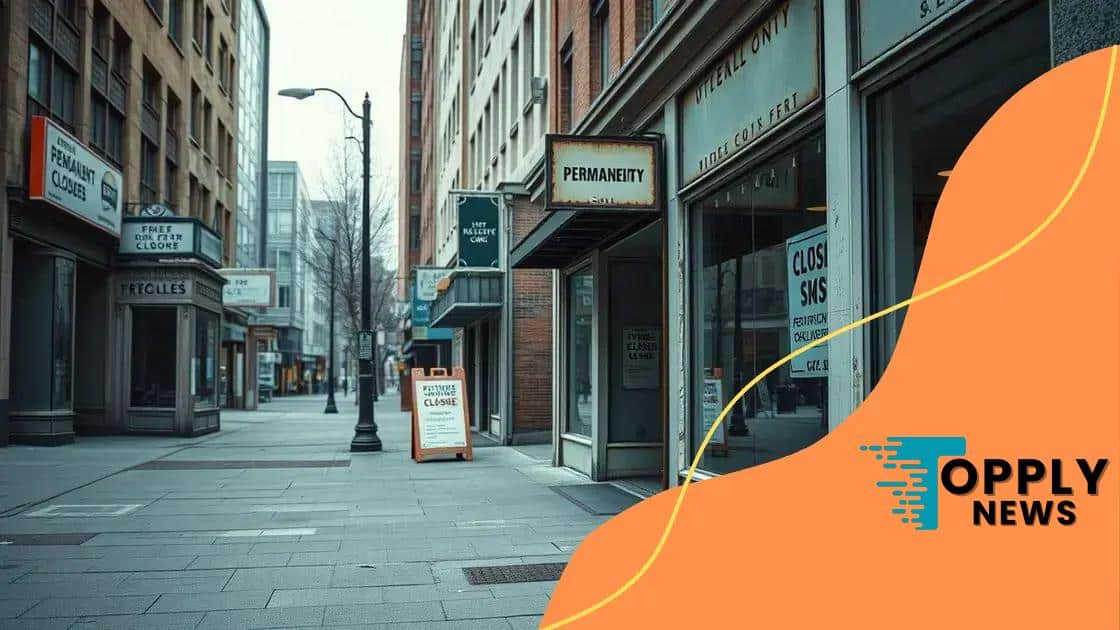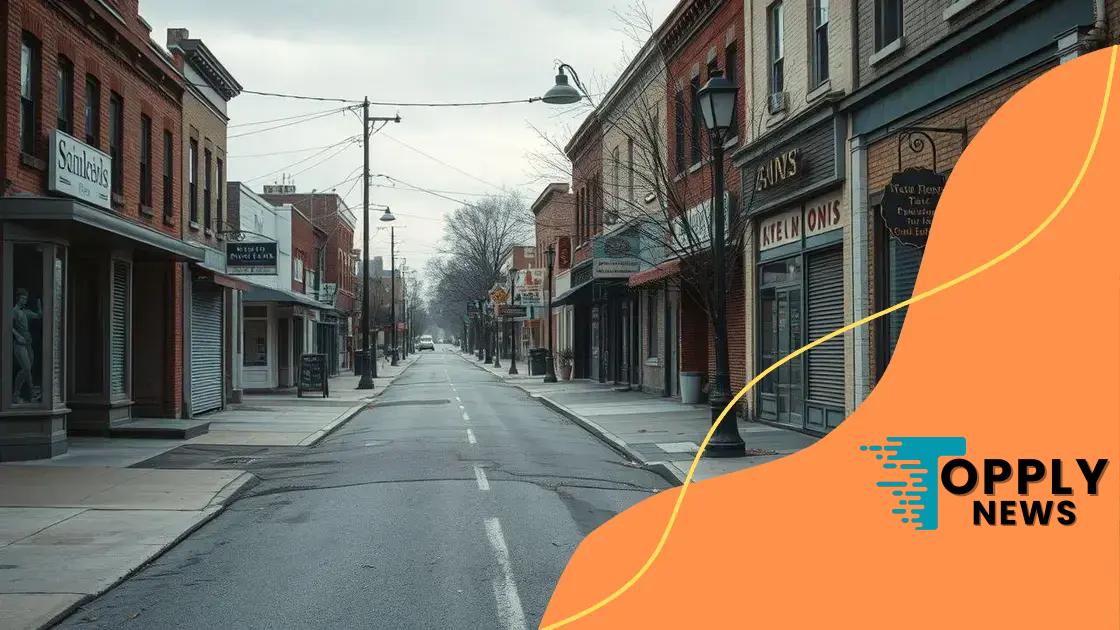Retail store closures May 2025: What you need to know

Retail store closures May 2025 are driven by increasing online shopping, economic pressures, and changing consumer preferences, greatly impacting local economies and shopping experiences.
Retail store closures May 2025 are looming on the horizon, sparking curiosity and concern. What’s causing this wave of shutdowns, and how will it affect our shopping experiences? Let’s dive into the details.
Current trends in retail store closures
Understanding the current trends in retail store closures is essential for consumers and businesses alike. This shift in the retail landscape is impacting how we shop and interact with our favorite stores.
Trends Shaping Store Closures
As we explore the reasons behind these closures, several key trends emerge.
- Growth of online shopping: More customers are turning to e-commerce for convenience.
- Economic pressures: Factors like inflation and reduced consumer spending influence store profitability.
- Shifting consumer preferences: Changes in interests and priorities affect which stores thrive.
Additionally, many retailers are downsizing their physical presence. This strategy helps them focus on profitable locations while minimizing costs. It’s not just big chains—many independent retailers face similar challenges.
The Rise of Omnichannel Retailing
To adapt, retailers are embracing omnichannel strategies. This approach integrates online and in-store experiences, making it easier for customers to shop. For example, a customer might browse online and pick up in-store, enhancing their experience.
The ability to offer flexible shopping options is crucial. As a result, we see many stores investing in technology to create seamless transactions. Along with better customer service, these innovations are reshaping the way we perceive shopping.
As store closures continue, it’s critical to stay informed about how your favorite retailers are adapting. By understanding these trends, consumers can make smarter choices about where to shop and which brands are likely to survive.
The current trends in retail store closures highlight the ongoing evolution of the retail world. Whether it’s shifting consumer preferences or the rise of online shopping, it’s clear that understanding these dynamics will be essential for the future.
Factors driving store closures in 2025
The factors driving store closures in 2025 are complex and multifaceted. As we look at the retail landscape, several reasons are emerging that explain why many stores are shutting their doors.
Economic Influences
Economic conditions play a significant role in determining the fate of retail stores. When inflation rises, many consumers cut back on spending. This shift impacts retailers, especially those that rely on discretionary purchases.
- Rising prices reduce purchasing power.
- Many consumers prioritize savings over non-essential goods.
- Increased competition from online retailers undercuts prices.
Retailers struggling to maintain sales often find it necessary to close underperforming locations. This trend can be seen across various sectors, from clothing stores to electronics.
Changing Consumer Behavior
Another driver of store closures is changing consumer behavior. More people prefer shopping online for convenience, leading to fewer footfalls in physical stores. This shift impacts both large and small retailers.
Moreover, many consumers now seek personalized experiences and unique products. Retailers that fail to meet these expectations often find themselves at a disadvantage. As a result, many are trying to adapt by enhancing their online presence and customer engagement strategies.
The impact of technology cannot be overlooked. Advances in e-commerce platforms and mobile shopping apps make it easier for consumers to shop from home. Retailers that do not keep pace with these changes risk falling behind.
Finally, external factors such as government policies and economic stability influence store closures. For instance, shifts in regulations and zoning laws can force stores to rethink their operations. With the ongoing uncertainty, many retailers are making tough decisions now to stay afloat.
Understanding the factors driving store closures in 2025 is crucial for consumers and industry stakeholders. By staying informed, both shoppers and businesses can navigate this evolving retail environment.
Impact of closures on local economies

The impact of closures on local economies is significant and multifaceted. When a retail store shuts down, it can disrupt the economic fabric of a community. These closures affect not only the businesses but also the customers and employees.
Job Losses
One immediate effect is job loss. Many employees face unemployment when local stores close. This job loss cascades through the community, leading to:
- Increased unemployment rates.
- Reduced spending power for former employees.
- Strain on social services as more people seek assistance.
It’s not just the individuals who lose their jobs; the local economy suffers due to decreased consumer spending. With fewer people employed, there is less money circulating within the community.
Reduced Local Revenue
Closures also mean a drop in local tax revenues. Retail stores contribute significantly to local taxes, which fund essential services such as schools and infrastructure. A decline in these revenues can lead to:
- Reduced funding for public services.
- Slower economic growth in the area.
- Challenges in maintaining community programs.
As local governments grapple with reduced funds, they may face tough choices, leading to service cutbacks or increased taxes for remaining businesses and residents.
Furthermore, the loss of retail options can harm the overall attractiveness of an area. With fewer shops and services available, potential new businesses may hesitate to invest. This cycle can lead to a gradual decline in the community’s vibrancy and appeal.
Community ties can also weaken when favorite local stores close. People often build relationships with business owners and employees, and closures can disrupt these connections. The absence of familiar stores can lead to a decrease in community pride.
Understanding the impact of closures on local economies is essential for communities to strategize recovery and revitalization plans. By supporting local businesses, communities can help mitigate some of these negative effects.
Future of shopping: adapting to changes
The future of shopping is evolving rapidly. As we see more store closures, consumers and retailers must adapt to stay relevant. Embracing new trends is crucial for survival in this changing landscape.
Embracing Online Shopping
One major change is the increase in online shopping. More people prefer the convenience of purchasing items from home. Retailers are responding by enhancing their digital platforms. This includes:
- Improving user experience on websites and apps.
- Offering same-day delivery options to meet consumer demand.
- Utilizing data analytics to personalize shopping experiences.
By transitioning to a strong online presence, retailers can reach a broader audience and maintain sales even when physical stores are closed.
Experiential Retail
Another trend is the rise of experiential retail. As more stores close, remaining retailers are focusing on creating unique in-store experiences. This strategy helps attract customers looking for more than just products.
For instance, stores might offer:
- Workshops or classes related to their products.
- Exclusive events for loyal customers.
- Interactive displays that allow hands-on experiences.
These efforts are essential for drawing customers away from their screens and back into stores. By creating memorable experiences, retailers can foster customer loyalty in a competitive market.
Additionally, many retailers are investing in social media to engage with customers. Effective use of social platforms helps businesses stay connected. Customers enjoy sharing their shopping experiences, which can drive word-of-mouth advertising.
The future of shopping will likely blend online and offline experiences, creating a seamless journey for consumers. Retailers must be flexible and ready to innovate as consumer preferences shift. Successfully responding to these changes will be key for businesses aiming to thrive in a challenging environment.
What consumers can expect amid closures
As store closures become more common, consumers are left wondering what to expect. The retail landscape is shifting, and understanding these changes will help shoppers adapt effectively.
Changes in Shopping Options
One thing consumers can expect is a decrease in the number of physical stores. This may lead to fewer choices for in-person shopping. Consumers might find that their favorite local shops have closed, forcing them to seek alternatives.
- Increased reliance on online shopping platforms.
- Fewer brick-and-mortar locations to visit for immediate purchases.
- Potential delays in receiving products ordered online.
As the shift occurs, there will be a growing focus on e-commerce. Retailers are investing in their online presence, aiming to provide more for their customers in digital spaces.
Exploration of New Brands
With many familiar stores closing, shoppers may be prompted to explore new brands. This exploration can lead to discovering innovative products and unique offerings. It can also change shopping habits and preferences.
Additionally, retailers might offer special promotions to attract customers to their remaining locations. These may include:
- Discounts for loyal customers.
- Exclusive deals for online shoppers.
- Special events to foster a sense of community.
The way consumers perceive brands may also change. As the competitive landscape shifts, companies must work harder to differentiate themselves. This evolution could lead to more personalized shopping experiences.
Understanding what to expect amid these closures can empower consumers to adapt. By seeking out new shopping experiences and taking advantage of online platforms, they can continue to find what they need. The consumer landscape will evolve, but there will always be ways to thrive in this changing environment.
FAQ – Questions about Retail Store Closures and Shopping Trends
What are the primary reasons for retail store closures?
The primary reasons include increased online shopping, economic pressures, and changing consumer behaviors, leading to decreased foot traffic in physical stores.
How can consumers adapt to fewer physical retail options?
Consumers can adapt by exploring online shopping platforms, discovering new brands, and taking advantage of special promotions offered by remaining retailers.
What benefits do experiential retail stores provide?
Experiential retail stores offer unique and interactive shopping experiences, which help attract customers and create a sense of community.
How can shoppers stay informed about changes in retail?
Shoppers can keep up-to-date by following local news, subscribing to newsletters from their favorite brands, and engaging with retailers on social media.





